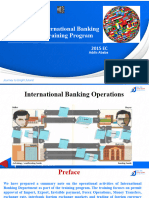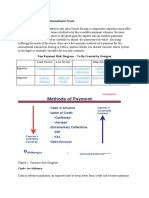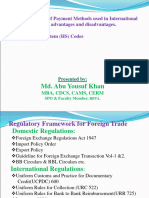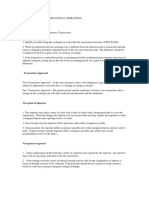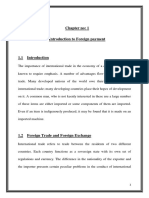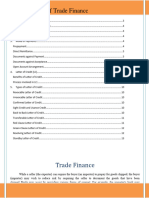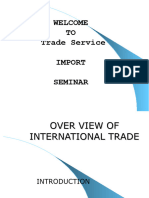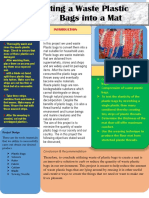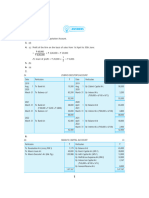What Are the Risks of International Banking?
1.
o Foreign banking is not a risk-free enterprise.
The exploding growth of business technology has effected growth in domestic and international business
operations. This growth contributes to an increased demand in foreign currency banking and investing services.
Since foreign countries have varying political and business environments compared with the United States, you
may run several risks when using international bank services. Common types of foreign banking risk include
currency exchange rates, political or military coups and the need to account for financial information according
to international accounting standards.
2. Currency Risk
o Conducting business internationally forces companies to become familiar with the currency
exchange rates. Companies choosing to operate business locations on foreign soil typically use foreign
currency when purchasing materials and hiring workers at the local facility. Start-up capital may come from the
company's domestic operations prior to the company exchanges it for foreign currency. If the U.S. dollar is
stronger than the value of the foreign currency, it will require more foreign currency to equal the value in U.S.
dollars. Conversely, if the U.S. dollar is weaker than the foreign currency, gaining an equal-value currency
exchange will require more dollars.
Exchange rates may affect profits made in a foreign country when companies transfer foreign currency to their
U.S. headquarters.
3. Political Risk
o U.S. companies might hesitate when conducting business internationally since foreign
countries may be less stable politically and economically. Situations such as political unrest, military coups,
dictatorships and anti-business groups can create difficult banking environments in foreign countries. These
political issues can make forecasting difficult because U.S. companies tend to lack familiarity with violent
political upheaval. Business-friendly countries might create unfavorable banking conditions or institute tougher
banking regulations to restrict foreign companies from dominating their local business market.
Accounting Risk
o U.S. companies are required to follow Generally Accepted Accounting Principle (GAAP) when
recording and reporting financial information from business activities located outside the United States. Publicly
held companies face close scrutiny by regulators because companies may use foreign business operations to
hide profits or losses. While these abuses might improve a company's domestic financial statements, external
audits will uncover these discrepancies and report the improprieties to outside stakeholders. International
banks may also be required to disclose which U.S. companies use their banking and investing services.
Foreign countries usually require the reporting of financial information according to international financial
accounting standards. These requirements mean U.S. companies must convert their GAAP-prepared
statements to international standards or keep a separate international accounting ledger for their foreign
operations. Either situation creates a lengthy and expensive process for the company's accounting process.
�Unit 10. Methods of International Settlements :
Unit 10. Methods of International Settlements
Slide 2:
International money transactions refer to the movement of funds from one country to another. The main reason for moving funds from one
country to another is the settlement of debts resulting from international trade.
Slide 3:
The methods of payment chiefly include remittance, collection and L/C. If the payment is made by remittance, it is called favorable exchange
(??), by which the buyer makes the payment by bank of his own accord; if by collection or L/C it is adverse exchange (??), by which the exporter
takes the initiative to gather payment from the buyer. To choose a method for the payment of the goods, you should consider the credit standing
of the buyer. Different methods of payment mean different credits. Bank credit (????) is more reliable than commercial credit (????). So, we
should choose the right method for the safe settlement of the payment.
I. Remittance :
I. Remittance
A. Definition :
A. Definition Remittance is to deliver the payment of the goods to the seller by bank transfer. In remittance, there are four parties involved: the
remitter, the beneficiary, the remitting bank and the paying bank. The remitter remits the money to the beneficiary as it is required by the contract
concluded between them. And when the remitter comes to the remitting bank, he fills an application form for the bank to effect the payment,
which upon remittance will be binding upon the remitting bank. And the paying bank pays the beneficiary because it is the branch bank or
correspondent bank of the remitting bank in the country of the seller. Remittance is mainly used for payment in advance (????) , open account
(??) for small quantity of goods, commission, sundry charges, etc. (a) If it is used for payment in advance or cash with order, it will place the
seller in an advantageous position. (b) If for delivery first and payment afterwards, it will place the buyer in a favorable position.
Note:Remittance uses commercial credit and hence in adopting this method, the parties involved need have trust in each other.
B. Types of Remittance :
B. Types of Remittance Money transfer can be channeled through banks by mail transfer (MT), telegraphic transfer (TT), and demand draft (DD).
(a) By mail transfer, the buyer will hand over the payment of the goods to the remitting bank that will authorize its branch bank or correspondent
bank in the country of the beneficiary by mail to make payment to him. (b) By telegraphic transfer, the buyer will hand over the payment of the
goods to the remitting bank which will authorize its branch bank or correspondent bank in the country of the beneficiary by telegraphic means to
made the payment to him. Mail transfer is cheap but time-consuming, while telegraphic transfer is more expensive but much faster. (c) By
demand draft, the buyer will come to the local bank to buy a banker’s bill and then deliver it to the seller or beneficiary by mail. When the seller
of beneficiary receives it, he will come to the bank designated by the banker’s bill for cash.
II. Collection :
II. Collection
A. Definition :
A. Definition Under collection, the exporter takes the initiative to collect the payment from the buyer. Upon the delivery of the goods, the
exporter draws a bill of exchange on the importer for the sum due, with or without relevant shipping documents attached, and authorizes his bank
to effect the collection of the payment through its branch bank or correspondent bank in the country of importer. collection can be of either
documentary collection (????) or clean collection (????). Documentary collection has the relevant shipping documents attached to the draft, while
in clean collection only draft is used. Documentary collection is most often used in the payment of goods in international trade while clean
collection is occasionally used in the payment of balance, extra charges, etc. Collection uses a commercial credit, and the banks involved do not
bear any risk if the payment of the goods is not made by the buyer. So before adopting this method, the seller should be sure that the buyer is
reliable and be able to make the payment.
�B. Parties Involved in Collection :
B. Parties Involved in Collection (a) The Principal (exporter or seller) ??? (b) The remitting bank (A bank at the place of the seller) ??? (c) The
collecting bank (correspondent or branch of the remitting bank) ??? (d) Drawee (buyer or importer) ??? (P–This is the person who draws the bill
of exchange and authorizes his bank to effect the collection.) (R-This is the bank authorized by the drawer of the draft to effect collection from
the buyer. It is usually the bank at the place of the seller.) (C-This is the bank authorized by the remitting bank to collect the payment from the
drawee, or the buyer of the goods. Usually this is the bank in the country of the buyer.) (D-The drawee is usually the buyer of the goods who
should make payments in time.)
C. Documents Against Payment (D/P) :
C. Documents Against Payment (D/P) Under D/P, the buyer can receive the shipping documents only after he has duly made the payment of the
goods. It can be further be of 2 types: D/P at sight and D/P at __ days after sight (date). ?D/P at sight. Under D/P at sight, the seller might draw a
draft on the buyer. He hands over the shipping documents together with draft, and the shipping documents and the draft will be transferred to the
collecting bank which present them to the buyer and ask him to make the payment at sight. The buyer, upon sight, should then make the payment
and obtain the shipping documents. When the collecting bank has finished the collection, it should immediately notify the remitting bank, which
will then make the payment to the seller. ?D/P at __ days after sight (date). Under D/P at __ days after sight (date), the buyer shall duly accept the
documentary draft drawn by seller at __ days’ sight upon first presentation and make payment on its maturity. The shipping documents are to be
delivered against payment only.
Slide 13:
Note: Under D/P, the buyer can not obtain the shipping documents if he does not make the payment, should this happen, the seller need first
negotiate with the buyer, and at the same time, he may consider if he can sell the goods to others or to ship the goods back, usually at his own
cost.
D. Documents Against Acceptance (D/A) :
D. Documents Against Acceptance (D/A) Under the D/A, the buyer can get the shipping documents from the collecting bank after he has duly
accepted the draft. This is only applicable to time draft. This is greatly convenience to the buyer, but it means much more risk for the seller, for
once he has delivered the shipping documents, he will have lost his title over the goods. D/A means more risks for the seller, for the buyer might
refuse to pay after he has accepted the draft and taken the delivery of the goods. Certainly the seller might sue the buyer, but as is often the case,
the buyer claims bankruptcy and then the seller can do nothing to remedy the situation.
III. Letter of Credit(L/C) :
III. Letter of Credit(L/C)
Slide 19:
As we can see, neither remittance nor collection is a safe means for the settlement of payment in international trade as both of them rely on
commercial credit. With the development of international trade, bank credit gets involved in the settlement of payment which provides it with
more secure means. L/C is the major means thus developed is now most often used in the settlement of payment in international trade.
A. Definition :
A. Definition In international trade practice, a L/C can be seen as a document by which a bank, upon the request of an importer, promises to
effect the payment of the goods to the exporter. Function of L/C: The L/C solves the possible problems arising from the distrust between the
seller and the buyer. Under L/C, the seller can feel assured that so long as he has made the delivery of the goods and got the required documents
he can get the payment of the goods in time and the buyer can also feel at ease that he can get the shipping documents at the same time when he
effects the payment of the goods.
�B. Parties Involved in L/C :
B. Parties Involved in L/C The applicant, who is usually the importer that applies to the bank for the L/C. Issuing bank, which opens the L/C
upon the request of the importer. Advising bank, or notifying bank, which is authorized by the issuing bank to transfer the L/C to the exporter’s
bank. Beneficiary, who is usually the exporter and is entitled to use the L/C for the payment of the goods. Negotiating bank, which is willing to
buy on discount the documentary draft drawn by the beneficiary. Paying bank, which is designated by the L/C to pay the draft. Confirming bank,
which is asked by the issuing bank to confirm the L/C. If a bank has confirmed the L/C, it holds itself responsible for the negotiation or payment
of the L/C.
C. The Main Contents of L/C :
C. The Main Contents of L/C (a) The parties involved, including the applicant, the issuing bank, negotiating bank, the paying bank, etc. (b)
Remarks about the L/C: such as the No. of the L/C, its type, the issuing date, etc. (c) The amount of the L/C (d) The clauses of the bill of
exchange, such as the amount of the bill, drawer and drawee, the paying date, etc. (e) The clauses about the documents, what documents are
required, such as the invoice, the bill of lading, the insurance policy, the packing list (???), the certificate of origin, and inspection certificate, etc.
Also, the required member of copies of the documents, description of the goods, specifications, quantity, packing, unit price, total amount, mode
of transport, place of unloading, etc. (f) Particular clauses, such as the special provisions about the deal in accordance with the particular business
or political situations of the importing country. (g) Guarantee clauses of the issuing bank, which testifies that the issuing bank will hold itself
responsible for the payment to the beneficiary or the holder of the draft.
D. Revocable L/C & Irrevocable L/C :
D. Revocable L/C & Irrevocable L/C Revocable L/C (??????) is the one that can be withdrawn or amended by the issuing bank any time before
the negotiation, or acceptance, or payment is effected. In doing so, the issuing bank does not need to have the agreement or even notify the
beneficiary. This is rarely used in the settlement of payment in international trade. Irrevocable L/C (???????) is the one that cannot be withdrawn
or amended by the opening bank without the agreement of the beneficiary. This hind of L/C is more secure and hence is most often used. We
should note that, according to Uniform Customs and Practice of Commercial Documentary Credits 500, if a L/C is not marked as being
irrevocable, it should be taken as irrevocable.
Slide 24:
E. The Procedures Involved in the Use of L/C
Slide 25:
Thank you By Amps









